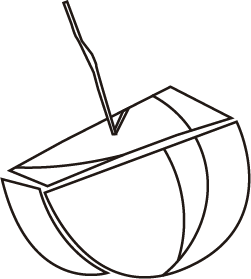THE TOWER OF LA FORADADA
 The tower of La Foradada is discerned from the quadrangular base of a building located at the top of the rock. There are also remains of a cistern next to the arch.
The tower of La Foradada is discerned from the quadrangular base of a building located at the top of the rock. There are also remains of a cistern next to the arch.
This watchtower must have had a considerable height, perhaps around 10 metres, according to experts. It was constructed with stones joined using a mortar mix. The interior was plastered and the floor was paved with a hardened layer of cement similar to that used for the mortar, but without stones.
On the south side it is still possible to see the remains of the old layout of the medieval wall that connected with the watchtower. This wall is about 50 cm thick and retains an average height of 80 cm. It is made of solid mortar.
The tower of La Foradada must have served for communicating between the two castles by way of bonfires or light signals, as it is located in the middle and in a strategic place in the mountains.
The research carried out by Josep Torró (2008) has provided very valuable information regarding the role that this fortification played in the time of the al-Azraq revolts. It seems that the fortification of La Foradada, in addition to acting as a place of shelter and as a base of operations, functioned as a kind of prison, where the rebel Arabs held Christian prisoners captured in the battles, waiting to receive a ransom in exchange for their release. Thanks to this research we also know the name that the Muslims gave to La Foradada: Mathqûba, which means exactly the same thing, “perforated”, “drilled”.
CHRONOLOGY
Excavations carried out have uncovered pale green and white glazed Muslim pottery from the 11th, 12th and 13th centuries and a bronze arrowhead. This confirms a purely Arab and post-caliphate chronology: it must have been built between 1076 and 1102. There is evidence of its occupation by Christian militias during the Muslim uprising of 1276-1277.
It must be borne in mind that in the area of La Foradada during the Bronze Age there was also a settlement or village whose remains can be seen by way of a wall made of large blocks of stone that runs almost parallel to the medieval wall, on the outside.
BIBLIOGRAPHY ABOUT THE TOWER OF LA FORADADA
AZUAR RUIZ, R. (1989): Dénia islàmica. Arqueología y poblamiento, Alacant.
RUBIO, FEDERICO. (1986): Penya Forada, Arqueología en Alicante 1976-1986. Instituto de Estudios Alicantinos Juan Gil Albert. Diputación Provincial de Alicante 1986. pp. 37-40.
RUBIO, F. (1988): Catálogo de yacimientos de materiales altomedievales y musulmanes, L’Ull del Moro, Alcoi.
SEGURA MARTÍ, J. Mª – TORRÓ ABAD, JOSEP: Torres i Castells de l’Alcoià-Comtat. Congrés d’Estudis de l’Alcoià-Comtat. Abril-maig, 1985. (La Foradà – número 31 del catàleg).
TORRO i ABAD, JOSEP (2008): La Penya Foradada i els captius del combat d’Alcoi (1276). Llibre de festes de Sant Jordi – Moros i cristians d’Alcoi. Abril 2008. pp. 138-140.


